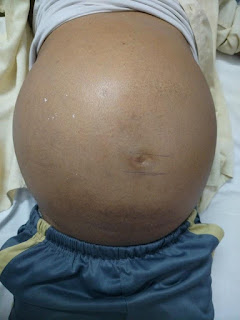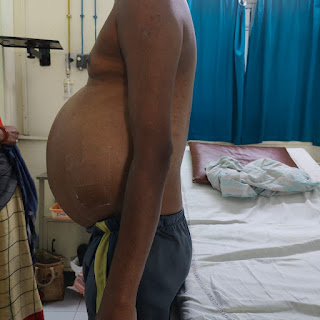48 YEAR OLD MALE WITH ABDOMINAL DISTENSION
This is an a online e log book to discuss our patient de-identified health data shared after taking his / her / guardians signed informed consent. Here we discuss our individual patients problems through series of inputs from available global online community of experts with an aim to solve those patients clinical problem with collective current best evident based input.
This E blog also reflects my patient centered online learning portfolio and your valuable inputs on the comment box is welcome.
I have been given this case to solve in an attempt to understand the topic of " patient clinical data analysis" to develop my competency in reading and comprehending clinical data including history, clinical findings, investigations and come up with diagnosis and treatment plan.
FATHER EXPIRED WHEN HE WAS A CHILD
DON'T KNOW THE CAUSE OF HIS DEATH
HIS MOTHER USED TO WORK AS A DAILY WAGE LABOURER .
HE WENT TO GOVERNMENT SCHOOL STUDIED UPTO 10Th
CLASS AND FAILED HIS FINAL EXAMS
ADOLESCENCE
HE WANTED TO ACHIEVE SOMETHING IN HIS LIFE SO HE STARTED PREPARING FOR RAILWAY
EXAMS
BUT UNFORTUNATELY ON THE DAY OF EXAM HE DID NOT FIND ANY VEHICLE TO REACH THE EXAM HALL AS DURING THAT TIME EVEN PUBLIC
TRANSPORT WAS NOT PROPERLY
AVAILABLE
SO HE LOST INTEREST IN HIS
STUDIES AND STARTED WORKING AS
DAILY WAGE LABOURER
AFTER MARRIAGE
HE HAD 2 CHILDREN ,ONE BOY AND ONE GIRL. 18 YEARS AGO STARTED DRINKING ALCOHOL MAINLY DURING SUMMER
SEASON ALONG WITH HIS FRIENDS.
15YEARS AGO BROUGHT AN AUTO FOR HIMSELF AND GAVE A PARTY TO HIS FRIENDS.HE GRADUALLY INCREASED
DRINKING ALCOHOL BECAUSE OF OTHER AUTO DRIVERS BECOMING HIS FRIENDS AND MORE FREQUENT GATHERINGS (2-3times a week), LATER INCREASED TO
260ml PER DAY OF WHISKEY
AROUND 2013 INCIDENTALLY
DIAGNOSED AS HYPERTENSIVE (ON TELMISARTAN)
HABIT TO ADDICTION
AROUND 2015 PATIENT HAD UNROLLING OF EYES WITH TRANSIENT LOC, NO FURTHER SUCH EPISODES LATER, 2016
PATIENTS HAD DRAGGING KIND OF FEELING IN ALL HIS EXTREMITIES AND GOT ADMITTED IN A HOSPITAL. HE WAS ASKED TO GIVE UP ALCOHOL BY THE DOCTORS
HE RESISTED HIMSELF NOT TO TAKE EVEN A DROP OF ALCOHOL FOR 2YEARS.
IN 2018 IT WAS HIS DAUGHTER'S
MARRIAGE WHEN HE WAS SERVING
ALCOHOL TO THE GUESTS, HIS RELATIVES ASKED HIM TO DRINK.
HE DRANK AGAIN AND IS NOT ABLE TO GIVE UP TILL NOW
WITHDRAWAL SYMPTOMS
HE COMPLAINED THAT IF HE DOESN'T
DRINK ALCOHOL HE IS HAVING INVOLUNTARY MOVEMENTS OF HANDS, TINGLING SENSATIONS OF HANDS AND SLEEP DISTURBANCES.
URGE FOR DRINKING+
NO CONTROL OVER THE AMOUNT OF ALCOHOL
UPON ALL THIS DUE HIS FINANCIAL ISSUES
(As he got his daughter married and couldn't make his son study after intermediate) HE DRANK MORE AND MORE ALCOHOL
HE KNOWS WHAT HARM ALCOHOL CAN DO TO HIM BUT HE COULD NOT GIVE UP.
ABDOMINAL DISTENSION
FROM APRIL 2021 PATIENT STARTED
HAVING ABDOMINAL DISTENSION AND OCCASIONAL SHORTNESS OF BREATH.
HE VISITED LOCAL DOCTOR, NO INVESTIGATIONS WERE DONE BUT HE WAS ADVISED TO USE TAB.DYTOR
10mg Half tab OD,TAB UDCA BD AND ADVISED TO STOP ALCOHOL
BUT HE DID NOT STOP DRINKING.
FROM 2018 HE IS HAVING ON AND OFF PEDAL ODEMA AND OLIGURIA ,WHICH USED TO GET RELIEVED BY DIURETICS
ON AND OFF
1YEAR AGO HE HAD 1 EPISODE OF HEMATEMESIS (fresh blood)BUT DID NOT VISIT DOCTOR
ALTHOUGH HE HAD ON AND OFF MILD ABDOMINAL DISTENSION AND PEDAL OEDEMA FROM 2YEARS IT NEVER BOTHERED HIM,BUT SINCE 20DAYS PATIENT IS COMPLAINING OF PROGRESSIVE ABDOMINAL DISTENSION WHICH BECAME TENSE TO THE PRESENT STATE ,ASSOCIATED WITH SHORTNESS OF BREATH ONLY ON WALKING ,GRADE 2 SINCE 20DAYS,NO HISTORY OF ORTHOPNEA,PND.
C/O PEDAL OEDEMA SINCE 20DAYS ,GRADUALLY PROGRESSED UPTO KNEE,PITTING TYPE.
C/O 1EPISODE OF BLOOD IN STOOLS 5DAYS AGO,PASSED FRESH BLOOD.
NO C/O FEVER,LOOSE STOOLS,VOMITING,DIARRHOEA,COUGH,CHEST PAIN,PALPITATIONS,SYNCOPAL ATTACKS,PAIN ABDOMEN,JAUNDICE,PRURITIS,CHANGE OF URINE OR STOOL COLOUR
K/C/O HYPERTENSION SINCE 10YEARS ON TELMISARTAN 40MG OD
Personal history:
Mixed diet
Alcoholic since 18years
Non smoker
Regular bowel and bladder habits
Reduced appetite since 20days
FAMILY HISTORY :Mother is a known case of HTN,No other relevant family history
Currently he is staying with his wife, mother ,son and daughter in law
Drug history:Using Tab Telmisartan 40mg,Used tab dytor and UDCA 2years ago.
ON EXAMINATION
GENERAL Examination:
Patient is conscious, coherent and co operative
Vitals at presentation:
PR-82bpm
BP-120/80mmhg
RR-22cpm
TEMP-98.3F
Grbs-117mg/dl
On admission
Abdominal girth 102cms
Pictures taken on day 3 of admission:
No pallor ,icterus,clubbing ,Cyanosis,lymphadenopathy
Pitting type of pedal edema+
Loss of muscle mass in extremities+
No alopecia
No gynecomastia
No spider angioma
No palmar erythema,contractures
Visible abdominal veins+
Asterixis: No
No loss of axillary hair
SYSTEMIC EXAMINATION:
PER ABDOMEN:
On admission
INSPECTION:
Shape of abdomen:Distended
Umbilicus:inverted
Skin over the abdomen is shiny
All quadrants are moving equally with respiration
No visible peristalsis, Hernial orifices intact
Visible superficial abdominal vein running vertically down is seen
External genitalia normal
PALPATION:
Temperature:Not raised
Tenderness:Absent
No Rebound tenderness
No guarding rigidity
No hepatosplenomegaly
Abdominal girth: 102cms
Direction of flow in left lateral abdominal vein is downwards (rapidly filling when the upper finger is released compared to when the finger below is released)
PERCUSSION:
Shifting dullness +
No fluid thrill
Puddles sign -not elicited
AUSCULTATION:
Bowel sounds+
No arterial bruit. venous him
CARDIOVASCULAR:
Inspection: precordium normal,apex beat :5th ICS half inch medial to mid
clavicular line
Palpation:inspectory findings confirmed, No thrills or parasternal heave
Auscultation: S152+, no murmurs
RESPIRATORY SYSTEM:
Inspection:
Shape of chest:Bilaterally symmetrical, Elliptical in shape
No visible chest deformities
No kyphoscoliosis,
Abdomino thoracic respiration, No irregular respiration
No tracheal shift
No dropping of shoulders, Spino scapular distance appears equal on both sides no sinuses scars engorged veins
PALPATION
Inspectory findings confirmed by Palpation
Chest movements - normal
Chest expansion-equal on both sides
Chest circumference at the level of nipple:84cms-on inspiration:87cms
AP diameter:20cms
Transverse diameter :32cms
PERCUSSION:
Resonant note heard over all areas
AUSCULTATION:
Norma vesicular breath sounds heard
Vocal resonance: normal in all areas
CNS:
Higher mental functions :intact
Cranial nerves intact
Motor system:Normal power,tone,Gait
Reflexes:normal
Sensory examination:Normal
No meningeal signs
Tremors : absent
CONSTRUCTIONAL APRAXIA TESTING
On the day of admission
Day 3 of admission
SURGERY REFERRAL TAKEN FOR BLOOD IN STOOLS:
On DRE:
Skin tag + in 4’O clock position
Fissure+ at 6’O clock position
Dilated veins+
On PROCTOSCOPY:
Dilated veins in 11’O clock and 3’O clock position
Multiple venous dilatations in anal canal
Bleeding on touch
Advised for Banding and sclerotherapy
FEVER CHART:
ECG:
ECHO:
No RWMA
Mild LVH+
Minimal pericardial effusion
Good LV systolic function
Grade 1 diastolic dysfunction
No PAH
RVSP:35mmhg
IVC :1.25cms,non collapsing
USG abdomen:
Liver :Normal size,coarse echo texture with surface irregularity,No IHBRD
Portal vein and CBD appear normal
Spleen:15cms ,increased size,normal echo texture
Pancreas:obscured by bowel gas
Kidneys:normal size,PCS and CMD, raised echogenecity
Prostate:normal size and echotexture
Impression:Gross ascites,splenomegaly,features suggestive of Cirrhosis of liver
Chest x ray:
Hemogram:
Hb :12.0
TLC: 14000cells/cumm
Platelets:2.05lakhs/cumm
Smear:Normocytic normochromic RBCs
LFT:
Total bilirubin: 1.92mg/dl by JENDRASSIC AND GROFFS Method
Direct bilirubin: 1.40mg/dl by JENDRASSIC AND GROFFS Method
SGOT:38IU/L by modified IFCC method
SGPT:12IU/L by modified IFCC method
ALP:193IU/L by PNPP-DEA method
TOTAL PROTEIN:6.5gm/dl by BIURET method
ALBUMIN: 2.25gm/dl by BCG
A/F 0.53
RFT:
Urea:32mg/dl. UREASE-GLDH
Creatinine 1.2mg/dl. Modified Jaffe’s
(Increased to 1.4mg/dl on day 2 of admission)
Uric acid 7.0mg/dl. Uricase POD with DHBS
Calcium:10.1mg/dl. Arsenazo III
Phosphorus:3.1mg/dl. Direct UV without reduction
Sodium:141meq/lit. Ion selective electrode
Potassium: 3.7meq/lit. Ion selective electrode
Chloride:104meq/lit. Ion selective electrode
All samples are centrifuged except for Hba1c
Centrifuge machine:
After centrifugation the sample is taken to other machine which mixes the sample with the reagent.Each test has different reagent for example
To measure serum albumin BCG reagent is used.
The reagent is placed in left sided compartment shown by black arrow
The sample is placed in right sided compartment shown in red arrow
Picture showing placement of samples
Parts of the above machine
After mixing the reagent the machine gives values to a connected computer
Different Methodologies used:
Absorbance photometry, Turbidimetry End-point, Fixed-time, Kinetic, optional ISE
Single / Dual reagent chemistries, monochromatic / bichromatic
Linear / non-linear calibration
Examples of few reagents and methods used in our lab:
Pictures:Taken from biochemistry laboratory
CUE:
Albumin 1+ by reagent strip method
Sugar nil by reagent strip method
Pus cells 3-4 by light microscopy
RBC nil by light microscopy
No casts or crystals in light microscopy
PT. 18 seconds
INR 1.3
APTT. 37seconds
HIV:Negative
HBsAG:Negative
HCV:Negative
UGIE:
Showing grade 4 esophageal varices
Adviced for Endoscopic band ligation
Ascitic fluid analysis
1litre therapeutic ascitic tap done on day 2 of admission
Complications of portal hypertension include:
- Thrombocytopenia due to congestive hepatopathy
- Abdominal wall collaterals
- Variceal bleeding secondary to hemorrhage from gastroesophageal, anorectal, retroperitoneal, stomal, and other varices
- Acute bleeding or iron deficiency anemia due to chronic blood loss from portal hypertensive gastropathy, enteropathy, or coagulopathy
- Ascites
- Spontaneous bacterial peritonitis
- Hepatic hydrothorax
- Hepatorenal syndrome
- Hepatic encephalopathy
- Hepatopulmonary syndrome
- Portopulmonary hypertension
- Cirrhotic cardiomyopathy

































Comments
Post a Comment